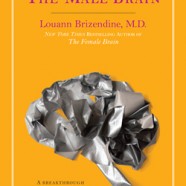
In my last blog, I wrote about–and recommended–Louann Brizendine’s 2006 book, The Female Brain. I now follow-up with her 2010 book, The Male Brain. Dr. Brizendine is a neuropsychiatrist at the University of California, San Francisco, and founder/director of the Women’s Mood and Hormone Clinic. To repeat myself, “In the past three or four years, there are few books I have recommended to my clients–both male and female–more than (The Female Brain). On my office shelving, the book indeed looks like a ‘classic’, given the many readings and highlights I have devoted to it.” Because of its 2010 publication date, I now revise that statement to read: “In the past two years, there are few books I have recommended to my clients–both male and female–more than (The Male Brain).”
Like its female predecessor, The Male Brain follows a developmental outline: the boy brain, the teen boy brain, the brain in love, the daddy brain, the mature male brain, and a chapter on the emotional lives of men. I’m imagining that women reading these words might be very interested in the subject matter about now. Men too, of course.
I’ve chosen a sampling from Dr. Brizendine’s chapter on the emotional lives of men; for example, as it relates to a man’s capacity to “listen, and not fix” women’s problems.
“Until recently, differences in how men and women feel and express emotions were thought to be due to upbringing alone. And to be sure, how our parents raise us can reinforce or suppress parts of our basic biology. But we now know that the emotional processing in the male and female brain is different. Research has suggested that our brains have two emotional systems that work simultaneously: the mirror-neuron system or MNS, and the temporal-parietal junction system, or TPJ. Males seem to use one system more, and females seem to use the other system more.
If we could scan (a man’s brain when a woman complains), we’d see both of his systems for reading emotions switching on. First, his MNS would activate. The mirror neurons that make up his MNS would allow him to briefly feel that same emotional pain he was seeing on (her) face. This is called emotional empathy. Next, we’d see his brain’s analyze-and-fix-it circuits being activated by the TPJ as it searched his entire brain for solutions. This is called cognitive empathy….As we watched (his) brain formulating a solution, we’d see his cortex activate as he matter-of-factly asked (her), ‘How many people will it take to get it done on time?’ (perhaps receiving a resentful look and question: ‘What difference does that make?!?!’)….(His) brain would entirely miss the desperate tone of her voice, since his TPJ would be busy working out the solution and his MNS would no longer be activating. Thus he’d be unable to notice the hurt expression in her voice and on her face….She was convinced that (his) analytical response meant that he didn’t understand how she felt and didn’t care. But he did care. He was simply trapped in his male brain circuit loops. His male brain was using the TPJ for cognitively processing emotions and getting to a ‘fix it fast’ solution. Her female brain’s MNS was misinterpreting his blank facial expression….The difference–for reasons scientists don’t understand–is that the female brain stays in the MNS longer, while the male brain quickly switches over to the TPJ” (pp. 97-98).
From a man’s point-of-view, solving problems is one way to show love and concern. But, Dr. Brizendine is obviously, and also, urging men to just “Shut up and listen”!

